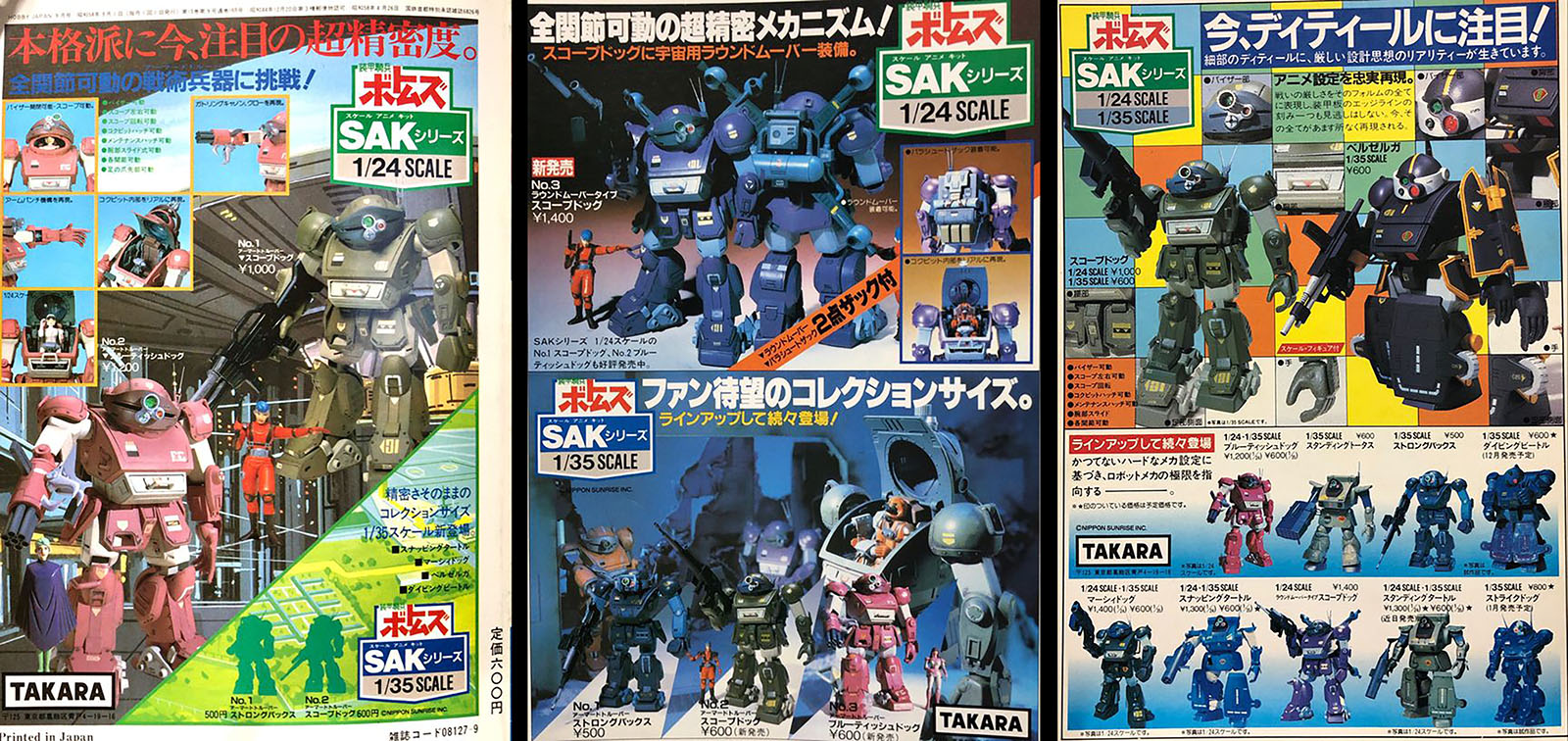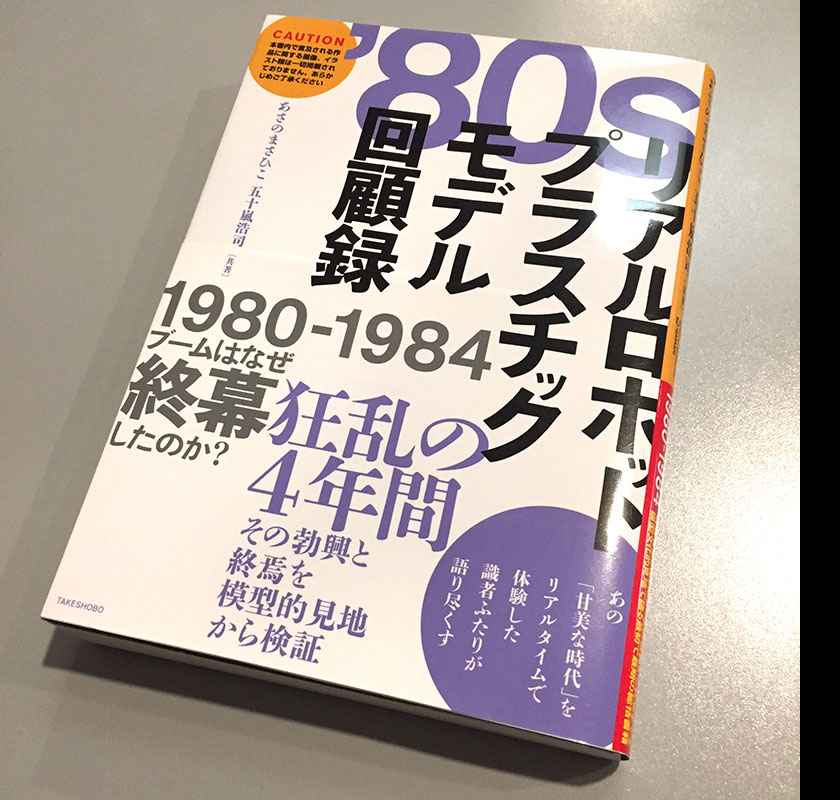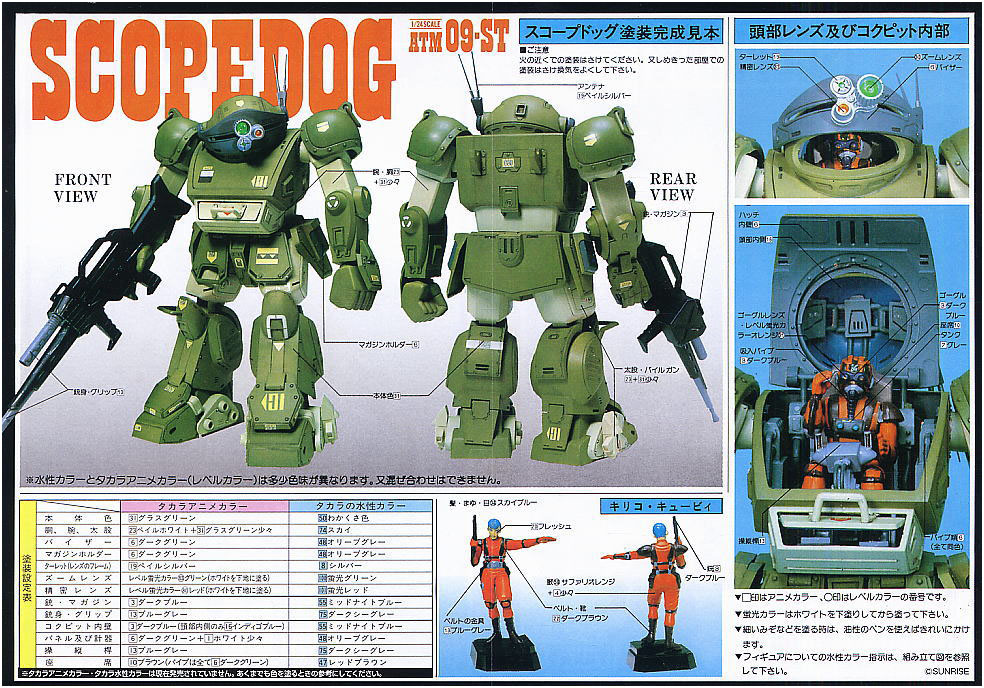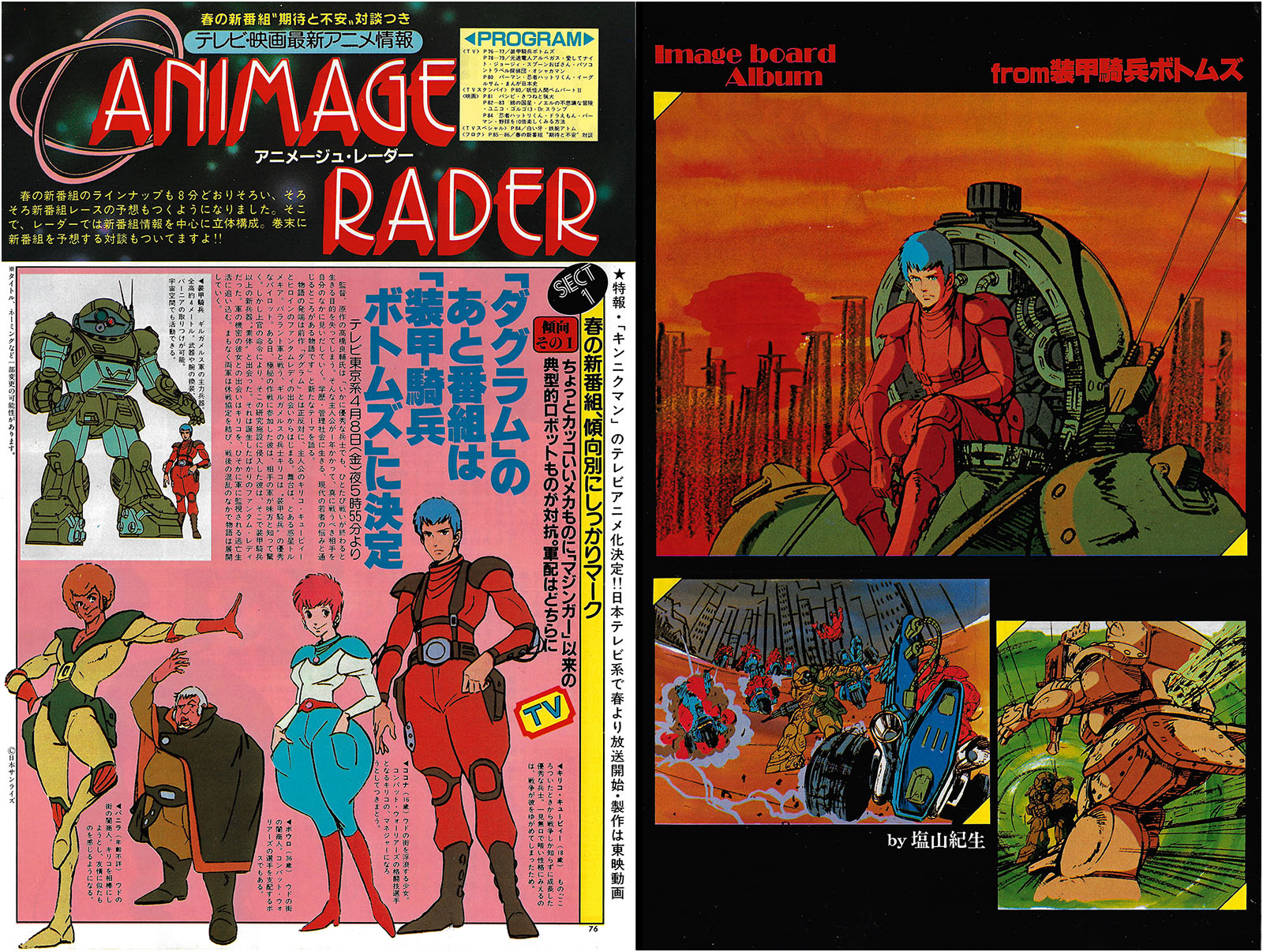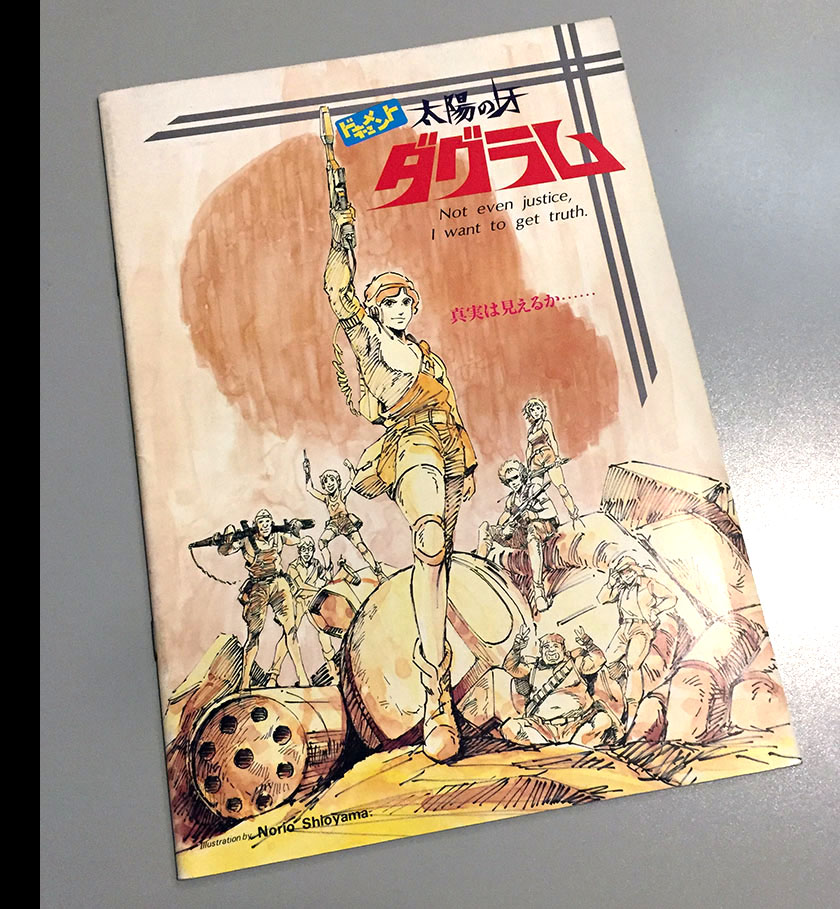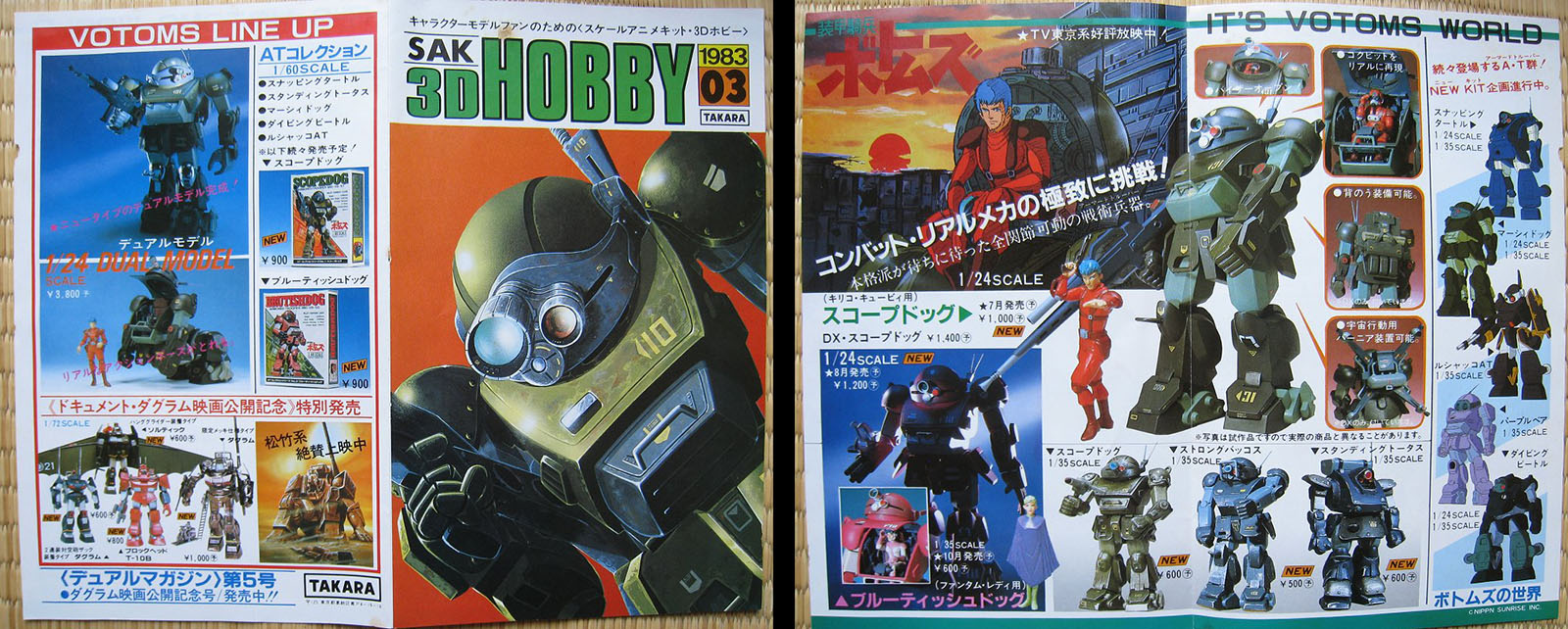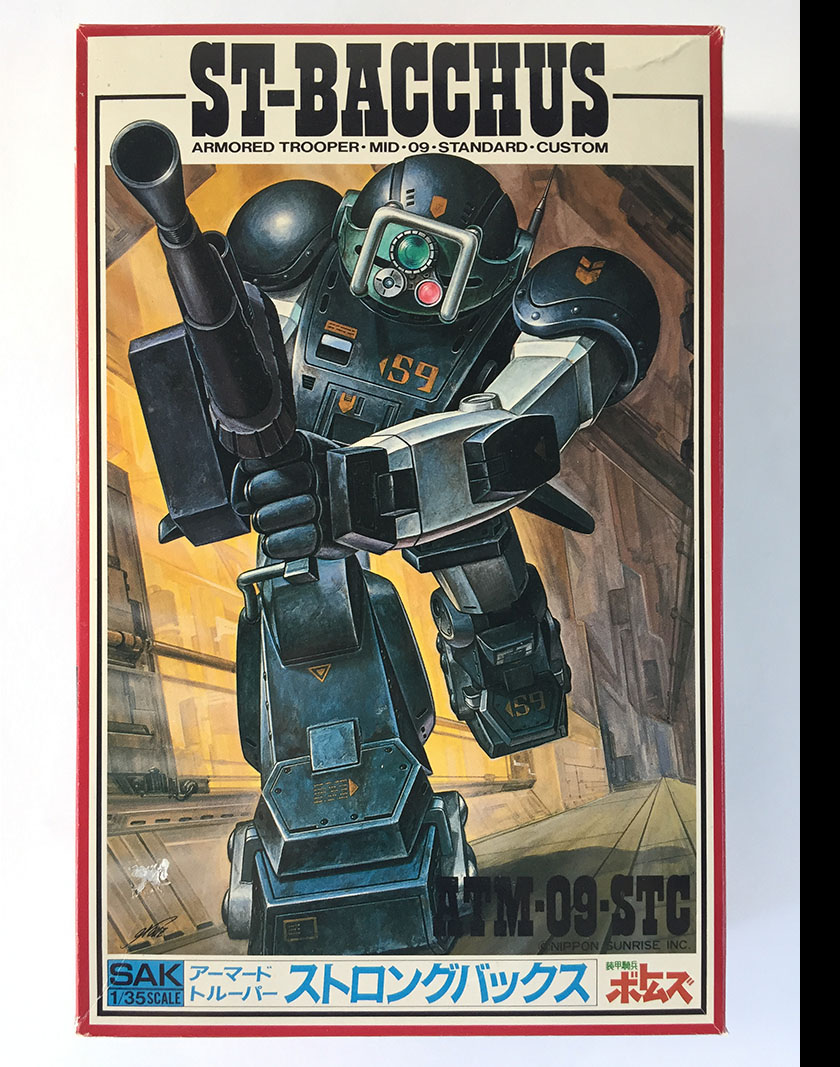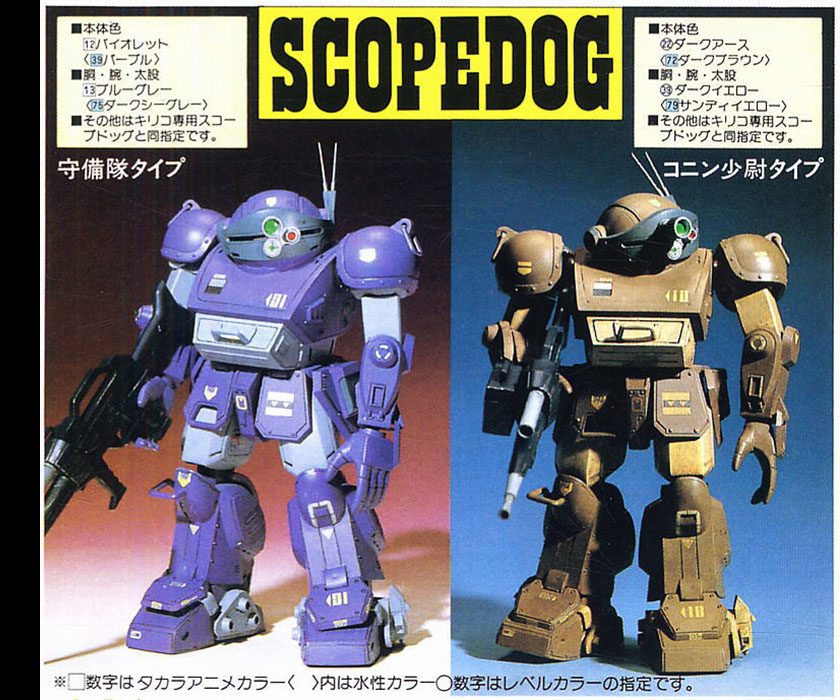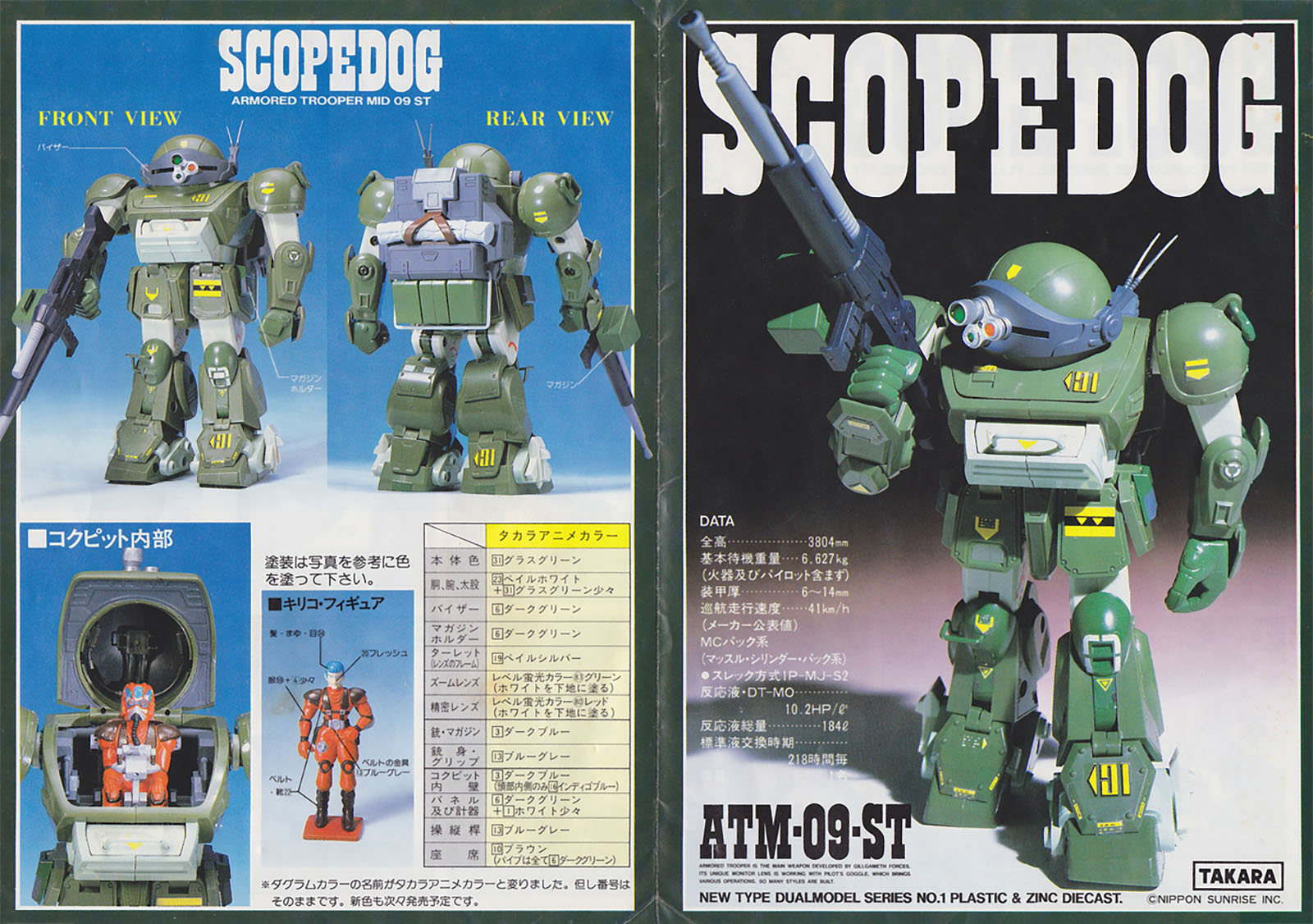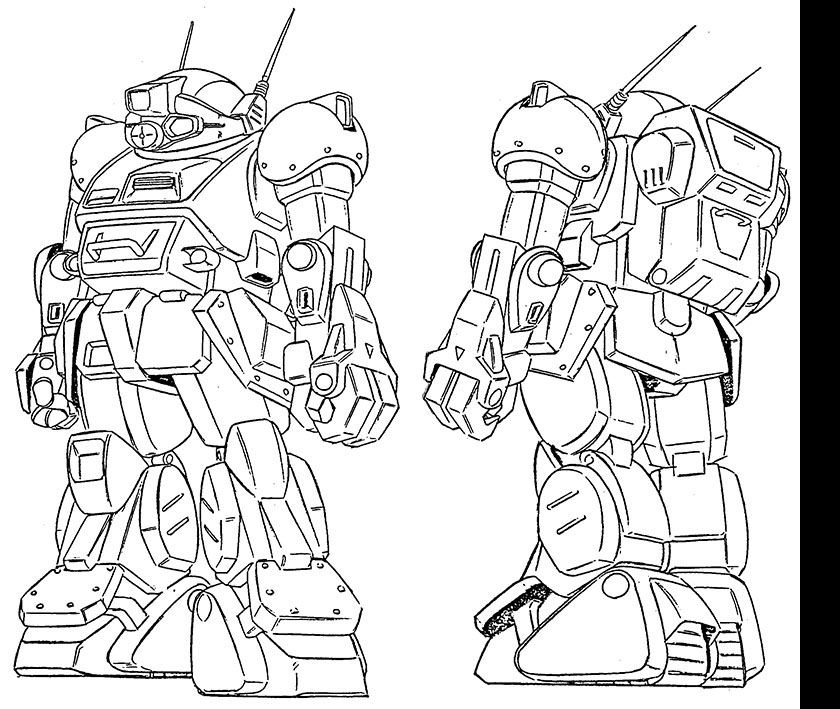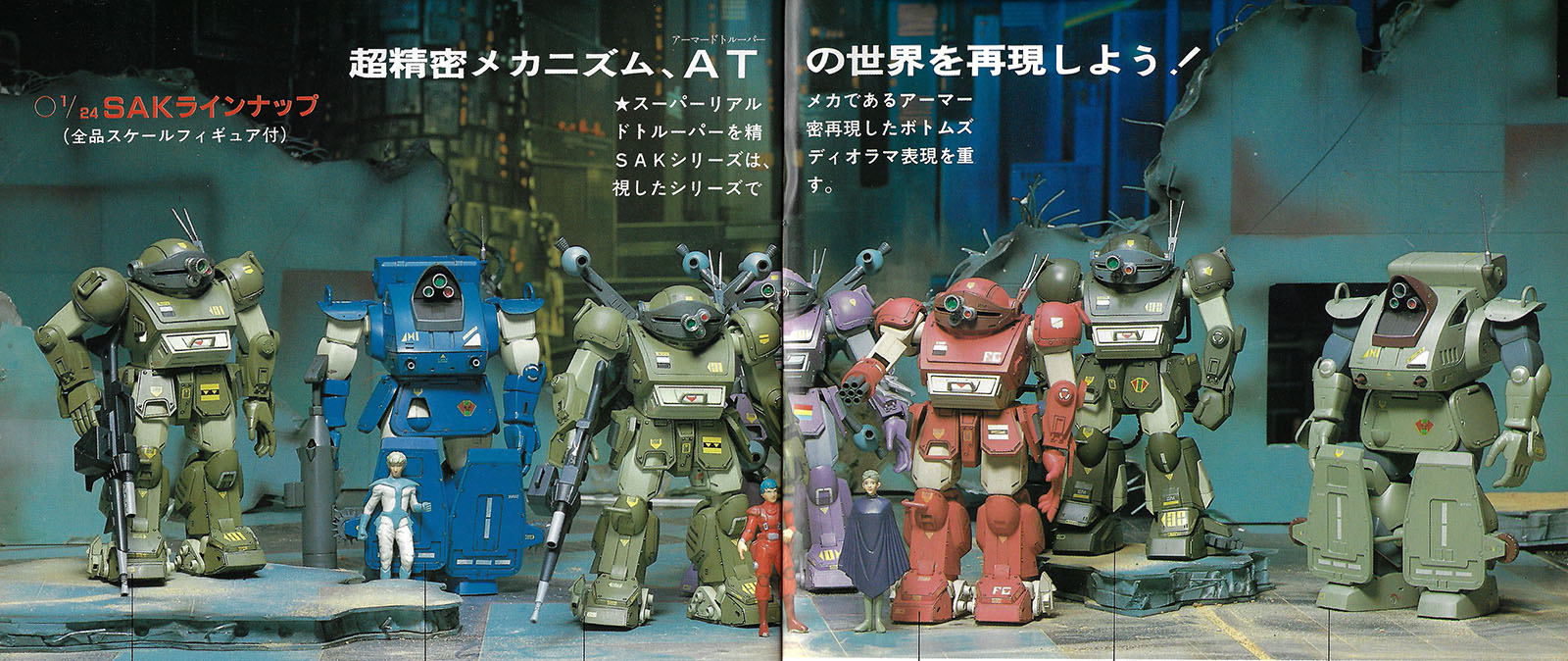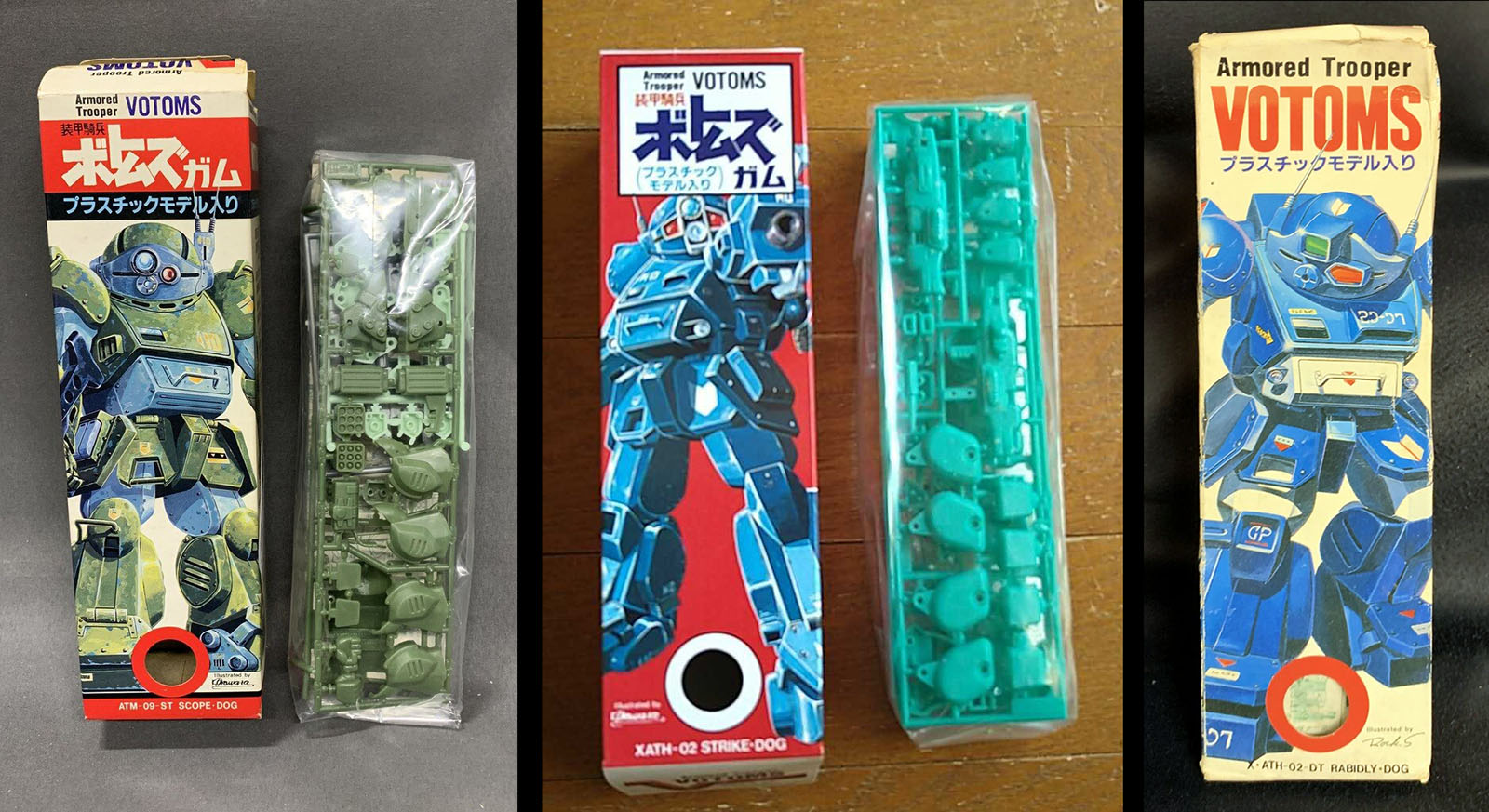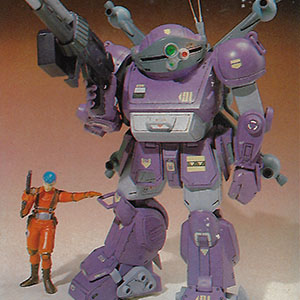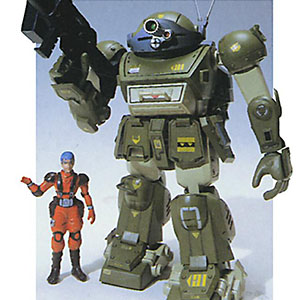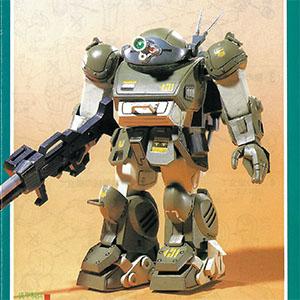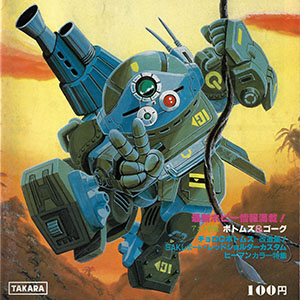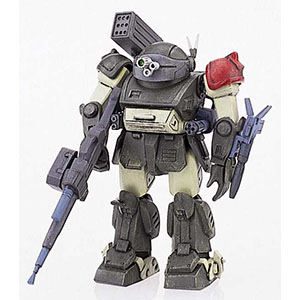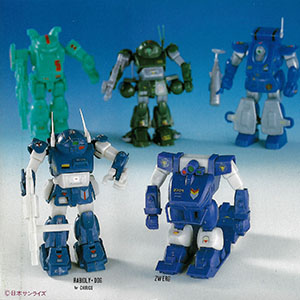Vintage model kits
When Armored Trooper Votoms arrived in April 1983, the anime plamo (plastic model) boom was in full bloom. Ignited by Mobile Suit Gundam in 1979/80, it took off like nothing seen before. Anime-based model kits weren’t new, but the “real robot” movement was a perfect storm of mecha design and plamo engineering that brought a new level of quality and realism to the craft. In the 70s, robot models looked like toys. In the 80s, they looked like the images that formed in your mind as you watched anime robots on your TV screen. Few product lines grasped the full potential of this dynamic the way Votoms did.
The company that broke the mold (so to speak) was Takara, which launched the TV series and produced all of the initial merchandising. They had previously struck plastic gold with Ryosuke Takahashi’s Fang of the Sun Dougram, so a production pipeline was already in place with a brand name that differentiated Takara kits from Bandai’s: SAK (Scale Anime Kit). Two other companies, Union and Kabaya, also joined the party with models in different scales to prevent overlap. All the models from these companies can be seen in the galleries below.
But first, some context.
’80s Real Robot Plastic Model Retrospective
Published in January 2022 by Take Shobo, this is a memoir by two men who were right in the crosshairs of the real robot plamo boom and have been reliving it on a professional level ever since. Here’s the official description of their book:
In the early 1980s, many boys were intoxicated by the frenzied boom, glued to their TV sets and buying plastic models and transformable toys. However, this frenzy came to an end after only a few years. In the fateful year of 1984, the boom was over in an instant, like the ebbing of the tide. What happened then?
In this book, Masahiko Asano, a writer on model culture who experienced the craze in real time, and Koji Igarashi, a researcher on anime and tokusatsu productions, re-examine the boom based on their memories and records of the time, its historical evaluation, and today’s aesthetic sense. They look back on the boom from its rise to its decline from their own unique perspectives.
Instead of a dry recounting of facts and figures, this is a transcribed dialogue between Asano and Igarashi, talking their way through the entire phenomenon. When I saw that they covered Votoms, I had to get a copy and translate that segment for this article. The book is 100% text, but if you feel like diving into these waters yourself, order a copy from Amazon.co.jp here.
Below is the Votoms conversation. Blue text was originally presented as footnotes.
The astonishment at Takara’s 1/24 “O-parts” Scopedog
Igarashi: Votoms premiered almost two months after Dunbine on April 1 (1983), right after the start of the MSV series. (Mobile Suit Gundam Variation model kits.)
Asano: Yes, that’s right. But let me tell you a personal story. I graduated from high school at that time, so I went on to a 3-year design school. As a result, every weekday I had to commute to Tokyo by train, which took about two hours each way. I could no longer visit my local model store. I used to go there every day from Monday to Friday and spend several hours there.
So now I could only get information about real robot anime plastic models from Hobby Japan and other publications. The amount of time for “direct observation at model retailers” and “confirmation of the content of each kit” began to drop dramatically. Even so, as much as possible, I continued to visit the toy department of the Tobu Department Store in the city where I would change trains, so I never felt that I was missing out on my mania. Still, April of 1983 was a very big turning point for me.
Igarashi: I see. That kind of change in your personal environment is something you can’t control, no matter how hard you try. Especially when you have to go to college or find a job.
Asano: Yes, that’s right. Regarding Votoms, before we talk about merchandising, let’s first talk about the reputation of the program at the time.
Even before Dougram started airing, there was already Dougram hype. “It’s definitely more realistic than Gundam, and the main mecha has no face!” And so on. On the other hand, there were no such reaction to Votoms, nobody saying, “It’s even better than Dougram!” At least not in my neighborhood.
Due to the round-headed shape and microscope-like turret lens, Asano thought the Scopedog’s design could never be called legitimate. On the other hand, despite the fact that he was from a region where Votoms wasn’t broadcast, Igarashi was won over the first time he saw the visuals. “A real robot design that has evolved more than two steps beyond the Zaku has appeared!”
The first time I saw an announcement was in Animage, where I saw the key visual of the Scopedog. I didn’t think it was cool at all. I was like, “What the-? Isn’t this mecha design more regressive than Dougram?”
Igarashi: You’ve been emphasizing this point for a long time.
Asano: Right. But when the anime actually started airing, I found that it was very well done. From the first episode, there were many depictions that took advantage of the height specs of the AT, and I was already saying to myself, “What is THIS?” The roller dash, turnpick, and arm punch were shown repeatedly, and it was a knockout. I was like, “This is what real robot anime is all about, isn’t it?” As soon as I saw it in action, the AT started to look cooler than Combat Armors or Mobile Suits, didn’t it?
I was in complete denial at the beginning, and then my table was flipped. The moment when the evaluation changes from black to white is actually the most pleasant feeling. That’s exactly what happened with Votoms. The depiction of the world itself was profound and cool. The main character, Chirico Cuvie, had an indescribable shadow. He was the type of character that “makes men fall in love with men.”
By the way, when Votoms models were first released, were Dougram kits still on the market?
Igarashi: Yes, they were. The Combat Armors that appeared in the latter half of Dougram, such as Bigfoot and Sabarov Nikolaev, overlapped with the AT of Votoms.
And on July 9 (1983), the Document Dougram and Xabungle Graffiti movies started to be shown at the same time. [Document Dougram theatrical program book shown at right.] Takara commemorated the Dougram movie premiere with four items at once: a Soltic with a hang glider, Dougram with an anti-aircraft gun, a Blockhead T-10B, and a limited plated-type Dougram.
Some of these kits included issue 3 of SAK 3D Hobby, Takara’s free in-house magazine, which pictured some Votoms kits. The Votoms SAK [Scale Anime Kit] series was announced in a big way in the magazine. Photos of the 1/24 Scopedog and Brutishdog were already being shown, but the name for Berserga was not decided yet, so it was called “Lu Shako AT.”
Dual Magazine was expensive and time-consuming to produce, and was distributed in bookstores. Therefore, the free SAK 3D Hobby pamphlets included with the Crusher Joe and Votoms model kits made for lighter footwork.
So, as it turns out, I believe that the development of Votoms products was slightly delayed due to the popularity of Dougram and the release of the movie. This was exactly the same as the relationship between Macross and Orguss. It was like, “The popularity of the previous show was so great that it slowed down the development of the new show’s products.”
What’s more, I was puzzled by the development of the Votoms series. The first kit released was the 1/35 Strongbox, which was a strange choice. The first kit in the series was a black-colored custom machine with a guard around the scope. So Strongbox was released in August. For some reason, the Scopedog, the star of the series, didn’t go on sale until September when the Kummen part was about to finish [the midpoint of the TV series], so that’s quite late for a release date, isn’t it?
Asano: But that’s only for the 1/35 line. The release of the l/24 scale Scopedog was not that late, right?
Igarashi: Yes, it was. The 1/24 scale Scopedog was released in July, I believe.
Asano: Well, I don’t understand why they put out the Strongbox at the beginning of the 1/35 line. I can only guess that development of the l/35 line did not progress well. There must have been a lot of time and energy devoted to the design and development of the 1/24 Scopedog.
As a matter of fact, the 1/24 Scopedog is considered a complete ornament, even when viewed from today’s perspective. For example, Bandai’s MSV series, which was coming out at the same time, faithfully reproduced the lines of Kunio Okawara’s design drawings. Basically, there was nothing added that wasn’t in the original design.
On the other hand, the 1/24 Scopedog was created from the perspective of “what if this actually existed in that world?” It was exquisitely detailed from a completely military point of view that did not exist in Mr. Okawara’s design.
For example, the armor around the waist, wrists, and legs. In the design drawing, they are simply riveted on. But the 1/24th Scopedog took it a step further so it wasn’t just a single plate of armor. The impression was that in order to achieve mobility, hardened armor was attached on top of the lighter armor and riveted in place. The same device is also used for the spherical armor on the shoulders. This could be interpreted as a strip of armor riveted on to increase strength at the edges. Because, if you think about it seriously from a military point of view, if cast metal armor was placed at such a high position, it would probably fall over when using a turnpick due to inertia.
Igarashi: In that sense, the 1/24 Scopedog is really an o-part, isn’t it? I have no doubt that it was one of big achievements of real robot anime plastic models at that time.
“O-parts” are “out-of-place artifacts” on a level considered totally outside the time and place in which they are found. With Takara’s 1/24th Scopedog it was, “I can’t imagine how such a high-quality product could be produced in the year 1983. I can’t come to a satisfactory conclusion.”
For example, the excellent Dual Model Scopedog toy, which was also 1/24 scale, used a metal frame to enable poses like the Dougram. But I didn’t really pursue militarism that much. If you were to ask, “Which of these most resembles Mr. Okawara’s design?” I would say it was the Dual Model, including the shape of the head.
Asano: Takara planned and developed the Dual Model toy separately, as it did with the Dougram. As for the model kits, a military maniac who wanted to become an industrial designer was in charge of product development, so the feeling was, “If the height of the robot is just under 4 meters, I can pursue a militarism that couldn’t be achieved with Dougram!”
I started to go on a rampage. The jewel of this rampage was the 1/24 Scopedog, and that’s what made it an o-part for me. However, thanks to the investment in product development they were able to produce almost all of the ATs during the latter half of the program.
Igarashi: If you look at it from a bird’s-eye view, it was similar to Bandai’s Xabungle and Dunbine in the same period.
However, compared to Dougram, where all the Combat Armors were released while extending the show, I think it was an unexpected event from Takara’s point of view. That’s why the ATs that appeared in the third arc and later in the Quent portion were not included. The same happened with Xabungle and Dunbine, but the sudden stall was surprising considering that all the Combat Armors in Dougram got released.
Asano: When it came to the l/24 line, they were able to release a few Scopedog variation kits. But the rest were only in the Turtle series.
Igarashi: When you take the variant kits into consideration, the 1/35 Strikedog was the last time they made a completely new mold. I was surprised that Fatty, Zwerg, and finally even Chirico’s Rabidlydog were never made. But by this time there was a glut of real robot anime plastic models, and sales per product would have dropped dramatically.
Previously, Chirico jumped into mass-produced ATs as needed, but the Rabidlydog was positioned as a “special machine for Chirico.” The fact that this AT was not commercialized was comparable to the 1/100 Walker Garrier from Xabungle not being released.
In the case of Votoms, the speed of commercialization was too slow and I think the price was a little too high. The 1/35 line, priced at 500 yen, was quite small in size when assembled, and I thought, “…What the heck?” It had good proportions, a lot of parts, and the weapons were included, but I think there was a vague sense of them being overpriced for the younger generation.
Asano: But then, the Dunbine kits of the same period also had a 500 yen base price, didn’t they?
Igarashi: That’s right. So in terms of user needs, I think it was possible that there were such ideas as “I don’t need a pilot figure, so maybe it could be 100 yen cheaper.” Also, Votoms was so thoroughly oriented toward the “mania” that it seemed to have an atmosphere of “not for beginners.”
Asano: Well, the anime is also completely mania-specific, completely hard boiled…
Igarashi: In that sense, unlike Dunbine, I would say that the plastic models and the anime were very well-matched. However, considering the historical background of the time, I wonder if it was a bit too highbrow.
Asano: But that’s why people who like Votoms are still building them without getting tired of them, whether it’s kit modification or garage kit conversion. Some builders continue to modify the Takara kits . Some choose to modify the 1/20 Scopedog released by Bandai in 2007. Others sell their own AT garage kits at sales events like Wonder Festival because it’s easy to obtain a license for the day of the event. This level of commitment in Votoms mania deserves to be called “unique.”
Igarashi: In that sense, Votoms had a unique charm! I have the feeling that it was an absolute work of art, never been seen before or since. But the savior of Votoms, was Kabaya, wasn’t it? The Fatty, Zwerg, and Rabidlydog that appeared toward the end of the show came out with Votoms Gum.
However, the problem was that although Kabaya called them “plastic models,” the molding material was polypropylene, a soft plastic that could not be used with any adhesives [*10]. But it was a very high degree of perfection, and satisfied my appetite for a certain level of quality.
Kabaya is a confectionery maker founded in 1946, shortly after the end of the war. In 1978, they released a toy candy called Big One Gum with a plastic model included. As a result, it enjoyed success as a long selling product. Votoms Gum was derivative of Big One Gum. The ATs Takara did not make into models were eagerly commercialized and received a great deal of support.
The assembly process was similar to that of a plastic model, but no glue could be used, and it couldn’t be modified or painted. However, even if you just assembled it according to the instructions, you would end up with a high degree of satisfaction. This was a dilemma for plastic model enthusiasts, for better or worse.
Asano: Kabaya’s Fatty and Zwerg were very good. They were much more satisfying than Union Model’s 200-yen series that came in the midst of the market. That reminds me, I was already into the world of garage kits at that time, so I wondered if I should seriously try to duplicate Kabaya’s Fatty and Zwerg in resin.
Igarashi: Oh, I know what you mean! The quality was high, and the size was quite large, about 1/35 scale.
Asano: Yes, that’s right. If you duplicated them in resin that way, you could solve the problem of molding materials. It would be possible to modify the model to 1/35 scale and paint it as well. However, if you seriously calculated the cost of silicone gum for duplication, it would be much more than a single piece of resin. I found out that it would cost a ridiculous amount of money to duplicate all the parts in a movable form.
Igarashi: So it was difficult with your financial situation at that time.
Asano: Yes, it was. If I’d had had more friends around me who were still crazy about real robot anime it could have been like crowd funding. If I could could have gathered about 15 people who said, “I will definitely buy it if the price is reasonable,” I would have been able to put the project into motion. However, I couldn’t go that far if it was just for myself.

